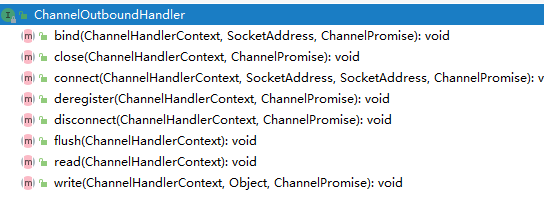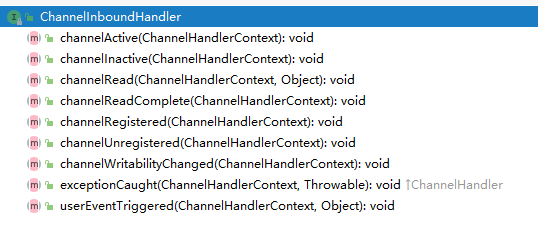本文聊一聊netty的ChannelHandler里面方法被调用的时机,这里面的方法大部分都是被netty回掉的,而不是我们主动调用。
下面的分析都是基于netty4来分析,netty将ChannelHandler分为的in和out两部分。下面看他们的方法签名。
方法签名
ChannelHandler:

主要就是handlerAdded 和 handlerRemoved方法,这两个方法在将handler添加到pipline和从pipline上移除时调用,与数据传输无关,所以放在了这个接口里面。
ChannelOutboundHandler:

ChannelInboundHandler:

调用逐个分析
handlerAdded
查看DefaultChannelPipeline类的addLast()方法。这个方法会先将handler封装成HandlerContext,然后添加到pipline尾部,最后调用callHandlerAdded0方法回掉handler的handlerAdded方法。
当发现此handler还没有registered,则将上面的操作创建成任务,等到registered后再执行。
1
2
3
4
5
6
7
8
9
10
11
12
13
14
15
16
17
18
19
20
21
22
23
24
25
26
27
28
@Override
public final ChannelPipeline addLast(EventExecutorGroup group, String name, ChannelHandler handler) {
final AbstractChannelHandlerContext newCtx;
synchronized (this) {
checkMultiplicity(handler);
newCtx = newContext(group, filterName(name, handler), handler);
addLast0(newCtx);
// If the registered is false it means that the channel was not registered on an eventLoop yet.
// In this case we add the context to the pipeline and add a task that will call
// ChannelHandler.handlerAdded(...) once the channel is registered.
if (!registered) {
newCtx.setAddPending();
callHandlerCallbackLater(newCtx, true);
return this;
}
EventExecutor executor = newCtx.executor();
if (!executor.inEventLoop()) {
callHandlerAddedInEventLoop(newCtx, executor);
return this;
}
}
callHandlerAdded0(newCtx);
return this;
}
handlerRemove
查看DefaultChannelPipeline的remove方法,会先从pipline链上找到handler对应的context,然后移除context,最后在方法callHandlerRemoved0()里回掉handlerRemove()。
1
2
3
4
5
6
7
8
9
10
11
12
13
14
15
16
17
18
19
20
21
22
23
24
25
26
27
28
private AbstractChannelHandlerContext remove(final AbstractChannelHandlerContext ctx) {
assert ctx != head && ctx != tail;
synchronized (this) {
atomicRemoveFromHandlerList(ctx);
// If the registered is false it means that the channel was not registered on an eventloop yet.
// In this case we remove the context from the pipeline and add a task that will call
// ChannelHandler.handlerRemoved(...) once the channel is registered.
if (!registered) {
callHandlerCallbackLater(ctx, false);
return ctx;
}
EventExecutor executor = ctx.executor();
if (!executor.inEventLoop()) {
executor.execute(new Runnable() {
@Override
public void run() {
callHandlerRemoved0(ctx);
}
});
return ctx;
}
}
callHandlerRemoved0(ctx);
return ctx;
}
channelRegistered
查看AbstractChannel内部类unsafe的下面方法,为了看起来更清晰我将它的注释删除了,此方法会先调用doRegister()方法,这个方法是要求子类实现的,然后在调用pipeline.fireChannelRegistered()来回掉pipline链上的channelRegistered()。
1
2
3
4
5
6
7
8
9
10
11
12
13
14
15
16
17
18
19
20
21
22
23
24
25
26
27
28
private void register0(ChannelPromise promise) {
try {
if (!promise.setUncancellable() || !ensureOpen(promise)) {
return;
}
boolean firstRegistration = neverRegistered;
//真实注册子类实现此方法
doRegister();
neverRegistered = false;
registered = true;
//没register之前添加到pipline上的handler,在这里真实添加
pipeline.invokeHandlerAddedIfNeeded();
safeSetSuccess(promise);
//回掉channelRegistered方法
pipeline.fireChannelRegistered();
if (isActive()) {
if (firstRegistration) {
pipeline.fireChannelActive();
} else if (config().isAutoRead()) {
beginRead();
}
}
} catch (Throwable t) {
closeForcibly();
closeFuture.setClosed();
safeSetFailure(promise, t);
}
}
pipeline.fireChannelRegistered()方法会首先调用head的channelRegister(),然后head会传递给下一个inChannelHandler节点。
1
2
3
4
5
@Override
public final ChannelPipeline fireChannelRegistered() {
AbstractChannelHandlerContext.invokeChannelRegistered(head);
return this;
}
channelActive
此方法在channel处理连接成功后回掉,如在程序内连接到其他网站,连接成功后回掉此方法。
因为只有客户端channel才能连接到其他服务器,serverChannel是被动连接的,所以此方法对serverChanel是无效的,但是serverChannel被连接时会生成的与之对应的clientChannel,此时会回调此方法。
查看AbstractNioChannel内部类unsafe的下面方法。
1
2
3
4
5
6
7
8
9
10
11
12
13
14
15
16
17
18
19
20
21
22
23
24
25
26
27
28
29
30
31
32
33
34
35
36
37
38
39
40
41
42
43
44
45
46
47
48
49
50
51
52
53
54
55
@Override
public final void connect(
final SocketAddress remoteAddress, final SocketAddress localAddress, final ChannelPromise promise) {
if (!promise.setUncancellable() || !ensureOpen(promise)) {
return;
}
try {
if (connectPromise != null) {
// Already a connect in process.
throw new ConnectionPendingException();
}
boolean wasActive = isActive();
//进行连接,
if (doConnect(remoteAddress, localAddress)) {
fulfillConnectPromise(promise, wasActive);
} else {
connectPromise = promise;
requestedRemoteAddress = remoteAddress;
// Schedule connect timeout.
int connectTimeoutMillis = config().getConnectTimeoutMillis();
if (connectTimeoutMillis > 0) {
connectTimeoutFuture = eventLoop().schedule(new Runnable() {
@Override
public void run() {
ChannelPromise connectPromise = AbstractNioChannel.this.connectPromise;
ConnectTimeoutException cause =
new ConnectTimeoutException("connection timed out: " + remoteAddress);
if (connectPromise != null && connectPromise.tryFailure(cause)) {
close(voidPromise());
}
}
}, connectTimeoutMillis, TimeUnit.MILLISECONDS);
}
promise.addListener(new ChannelFutureListener() {
@Override
public void operationComplete(ChannelFuture future) throws Exception {
if (future.isCancelled()) {
if (connectTimeoutFuture != null) {
connectTimeoutFuture.cancel(false);
}
connectPromise = null;
close(voidPromise());
}
}
});
}
} catch (Throwable t) {
promise.tryFailure(annotateConnectException(t, remoteAddress));
closeIfClosed();
}
}
此方法会调用子类的doConnect()方法,如果连接成功了doConnect返回true,如果还没连接成功,doConnect会注册OP_CONNECT事件到select里并返回false。
如果连接成功了,此方法会调用fulfillConnectPromise(),这里面回掉pipline的channelActive(),如果没连接成功,则添加超时时间的定时任务,超时事件内还没成功就取消连接并报错,并且没连接成功会注册OP_CONNECT事件到select内,当程序发现连接成功时,会处理CONNECT事件处理方法在下面。
1
2
3
4
5
6
7
8
9
10
11
12
13
14
15
16
17
18
19
20
21
22
23
24
25
26
27
28
29
30
31
32
33
34
35
36
37
38
39
private void processSelectedKey(SelectionKey k, AbstractNioChannel ch) {
final AbstractNioChannel.NioUnsafe unsafe = ch.unsafe();
if (!k.isValid()) {
final EventLoop eventLoop;
try {
eventLoop = ch.eventLoop();
} catch (Throwable ignored) {
return;
}
if (eventLoop == this) {
unsafe.close(unsafe.voidPromise());
}
return;
}
try {
int readyOps = k.readyOps();
if ((readyOps & SelectionKey.OP_CONNECT) != 0) {
//在这里处理OP_CONNECT事件,调用finishConnect方法
int ops = k.interestOps();
ops &= ~SelectionKey.OP_CONNECT;
k.interestOps(ops);
unsafe.finishConnect();
}
if ((readyOps & SelectionKey.OP_WRITE) != 0) {
ch.unsafe().forceFlush();
}
if ((readyOps & (SelectionKey.OP_READ | SelectionKey.OP_ACCEPT)) != 0 || readyOps == 0) {
unsafe.read();
}
} catch (CancelledKeyException ignored) {
unsafe.close(unsafe.voidPromise());
}
}
遇到op_connect事件就是调用unsafe.finishConnect()方法,在这个方法里调用fulfillConnectPromise方法里回掉channelActive方法。
1
2
3
4
5
6
7
8
9
10
11
12
13
14
15
16
17
18
19
20
21
22
@Override
public final void finishConnect() {
// Note this method is invoked by the event loop only if the connection attempt was
// neither cancelled nor timed out.
assert eventLoop().inEventLoop();
try {
boolean wasActive = isActive();
doFinishConnect();
fulfillConnectPromise(connectPromise, wasActive);
} catch (Throwable t) {
fulfillConnectPromise(connectPromise, annotateConnectException(t, requestedRemoteAddress));
} finally {
// Check for null as the connectTimeoutFuture is only created if a connectTimeoutMillis > 0 is used
// See https://github.com/netty/netty/issues/1770
if (connectTimeoutFuture != null) {
connectTimeoutFuture.cancel(false);
}
connectPromise = null;
}
}
read
上面调用了pipline.channelActive里,首先找到的head,它的方法里有一个readIfIsAutoRead(),如果此channel设置的是自动读,他会从pipline的尾部tail开始调用read方法,如果我们没重写read方法,最终会调用到head的read方法。
1
2
3
4
5
6
7
8
9
10
11
12
13
14
15
16
17
18
@Override
public void channelActive(ChannelHandlerContext ctx) {
ctx.fireChannelActive();
readIfIsAutoRead();
}
private void readIfIsAutoRead() {
if (channel.config().isAutoRead()) {
channel.read();
}
}
@Override
public final ChannelPipeline read() {
tail.read();
return this;
}
最终调用到下面代码,注册readInterestOp事件到select内。
1
2
3
4
5
6
7
8
9
10
11
12
13
14
15
16
17
18
19
20
21
22
23
24
25
26
27
28
29
30
31
32
33
34
35
36
@Override
public final void beginRead() {
assertEventLoop();
if (!isActive()) {
return;
}
try {
doBeginRead();
} catch (final Exception e) {
invokeLater(new Runnable() {
@Override
public void run() {
pipeline.fireExceptionCaught(e);
}
});
close(voidPromise());
}
}
@Override
protected void doBeginRead() throws Exception {
// Channel.read() or ChannelHandlerContext.read() was called
final SelectionKey selectionKey = this.selectionKey;
if (!selectionKey.isValid()) {
return;
}
readPending = true;
final int interestOps = selectionKey.interestOps();
if ((interestOps & readInterestOp) == 0) {
selectionKey.interestOps(interestOps | readInterestOp);
}
}
doBeginRead方法使用的readInterestOp并不一定是op_read,别被它的名称迷惑了,对于客户端的channel他是op_read,对于serverChannel他就是op_accept,是通过构造方法传进来的。
这样对于服务器在bind成功后就可以accept了,对于client在connect成功后就可以read了。
channelRead 和 channelReadComplate
这两个要在一起将,在客户端模式下,调用read注册op_read事件,下面是当有内容需要读取时的逻辑
1
2
3
4
5
6
7
8
9
10
11
12
13
14
15
16
17
18
19
20
21
22
23
24
25
26
27
28
29
30
31
32
33
34
35
36
37
38
39
40
41
42
43
44
45
46
47
48
49
50
51
private void processSelectedKey(SelectionKey k, AbstractNioChannel ch) {
final AbstractNioChannel.NioUnsafe unsafe = ch.unsafe();
if (!k.isValid()) {
final EventLoop eventLoop;
try {
eventLoop = ch.eventLoop();
} catch (Throwable ignored) {
// If the channel implementation throws an exception because there is no event loop, we ignore this
// because we are only trying to determine if ch is registered to this event loop and thus has authority
// to close ch.
return;
}
// Only close ch if ch is still registered to this EventLoop. ch could have deregistered from the event loop
// and thus the SelectionKey could be cancelled as part of the deregistration process, but the channel is
// still healthy and should not be closed.
// See https://github.com/netty/netty/issues/5125
if (eventLoop == this) {
// close the channel if the key is not valid anymore
unsafe.close(unsafe.voidPromise());
}
return;
}
try {
int readyOps = k.readyOps();
// We first need to call finishConnect() before try to trigger a read(...) or write(...) as otherwise
// the NIO JDK channel implementation may throw a NotYetConnectedException.
if ((readyOps & SelectionKey.OP_CONNECT) != 0) {
// remove OP_CONNECT as otherwise Selector.select(..) will always return without blocking
// See https://github.com/netty/netty/issues/924
int ops = k.interestOps();
ops &= ~SelectionKey.OP_CONNECT;
k.interestOps(ops);
unsafe.finishConnect();
}
// Process OP_WRITE first as we may be able to write some queued buffers and so free memory.
if ((readyOps & SelectionKey.OP_WRITE) != 0) {
// Call forceFlush which will also take care of clear the OP_WRITE once there is nothing left to write
ch.unsafe().forceFlush();
}
// 这里可以看出当是OP_READ 或者 OP_ACCEPT时均回掉unsafe.read();
if ((readyOps & (SelectionKey.OP_READ | SelectionKey.OP_ACCEPT)) != 0 || readyOps == 0) {
unsafe.read();
}
} catch (CancelledKeyException ignored) {
unsafe.close(unsafe.voidPromise());
}
}
这里可以看出当是OP_READ 或者 OP_ACCEPT时均回掉unsafe.read(),虽然调用的方法名称是read(),但对于客户端来说是read数据,对于服务器来说是accept,处理逻辑是写在unsafe子类里面的,
下面先看客户端的
1
2
3
4
5
6
7
8
9
10
11
12
13
14
15
16
17
18
19
20
21
22
23
24
25
26
27
28
29
30
31
32
33
34
35
36
37
38
39
40
41
42
43
44
45
46
47
48
49
50
51
52
53
54
55
56
57
@Override
public final void read() {
final ChannelConfig config = config();
if (shouldBreakReadReady(config)) {
clearReadPending();
return;
}
final ChannelPipeline pipeline = pipeline();
final ByteBufAllocator allocator = config.getAllocator();
final RecvByteBufAllocator.Handle allocHandle = recvBufAllocHandle();
allocHandle.reset(config);
ByteBuf byteBuf = null;
boolean close = false;
try {
do {
byteBuf = allocHandle.allocate(allocator);
allocHandle.lastBytesRead(doReadBytes(byteBuf));
if (allocHandle.lastBytesRead() <= 0) {
// nothing was read. release the buffer.
byteBuf.release();
byteBuf = null;
close = allocHandle.lastBytesRead() < 0;
if (close) {
// There is nothing left to read as we received an EOF.
readPending = false;
}
break;
}
allocHandle.incMessagesRead(1);
readPending = false;
pipeline.fireChannelRead(byteBuf);
byteBuf = null;
} while (allocHandle.continueReading());
allocHandle.readComplete();
pipeline.fireChannelReadComplete();
if (close) {
closeOnRead(pipeline);
}
} catch (Throwable t) {
handleReadException(pipeline, byteBuf, t, close, allocHandle);
} finally {
// Check if there is a readPending which was not processed yet.
// This could be for two reasons:
// * The user called Channel.read() or ChannelHandlerContext.read() in channelRead(...) method
// * The user called Channel.read() or ChannelHandlerContext.read() in channelReadComplete(...) method
//
// See https://github.com/netty/netty/issues/2254
if (!readPending && !config.isAutoRead()) {
removeReadOp();
}
}
}
}
下面是服务端的
1
2
3
4
5
6
7
8
9
10
11
12
13
14
15
16
17
18
19
20
21
22
23
24
25
26
27
28
29
30
31
32
33
34
35
36
37
38
39
40
41
42
43
44
45
46
47
48
49
50
51
52
53
54
55
56
57
58
59
60
61
62
@Override
public void read() {
assert eventLoop().inEventLoop();
final ChannelConfig config = config();
final ChannelPipeline pipeline = pipeline();
final RecvByteBufAllocator.Handle allocHandle = unsafe().recvBufAllocHandle();
allocHandle.reset(config);
boolean closed = false;
Throwable exception = null;
try {
try {
do {
int localRead = doReadMessages(readBuf);
if (localRead == 0) {
break;
}
if (localRead < 0) {
closed = true;
break;
}
allocHandle.incMessagesRead(localRead);
} while (allocHandle.continueReading());
} catch (Throwable t) {
exception = t;
}
int size = readBuf.size();
for (int i = 0; i < size; i ++) {
readPending = false;
pipeline.fireChannelRead(readBuf.get(i));
}
readBuf.clear();
allocHandle.readComplete();
pipeline.fireChannelReadComplete();
if (exception != null) {
closed = closeOnReadError(exception);
pipeline.fireExceptionCaught(exception);
}
if (closed) {
inputShutdown = true;
if (isOpen()) {
close(voidPromise());
}
}
} finally {
// Check if there is a readPending which was not processed yet.
// This could be for two reasons:
// * The user called Channel.read() or ChannelHandlerContext.read() in channelRead(...) method
// * The user called Channel.read() or ChannelHandlerContext.read() in channelReadComplete(...) method
//
// See https://github.com/netty/netty/issues/2254
if (!readPending && !config.isAutoRead()) {
removeReadOp();
}
}
}
}
从代码能看出对于client的channel多次读取数据调用pipeline.fireChannelRead(byteBuf),最后调用一次pipeline.fireChannelReadComplete(),
对于server模式的channel,也有read方法,但它读取到的不是数据而是子连接,然后调用pipline的fireChannelRead方法处理子连接,具体处理逻辑在ServerBootStrap里面,就是对子连接进行config,然后注册到serverChannel相同的eventLoop里面。
channelInactive,channelUnregistered,handlerRemoved
有很多因素会导致channelInactive,当连接断开,报错,主动断开等等,会依次回掉上面三个方法。
可以查看pipline.close()方法,逻辑不复杂,先关闭java的channel,并且从select中删除注册的channel。
exceptionCaught
如果在某个handler内报错了,则会调用当前handler的exceptionCaught方法,默认情况下未重写方法时是继续向下查找。如果在监听器内报错了,则会调用head节点的exceptionCaught。
##
bind
这个方法是socket作为server注册时,绑定到本地端口时使用的,查看AbstractBootstrap的bind方法,会调用pipline的bind方法,这属于出站消息,先调用tail的bind方法,如果没重写此方法,最终调用head的bind方法。
1
2
3
4
5
6
7
8
9
10
11
12
13
14
15
16
17
18
19
20
21
22
23
24
25
26
27
28
29
30
31
32
33
34
35
36
37
38
39
40
41
@Override
public final void bind(final SocketAddress localAddress, final ChannelPromise promise) {
assertEventLoop();
if (!promise.setUncancellable() || !ensureOpen(promise)) {
return;
}
// See: https://github.com/netty/netty/issues/576
if (Boolean.TRUE.equals(config().getOption(ChannelOption.SO_BROADCAST)) &&
localAddress instanceof InetSocketAddress &&
!((InetSocketAddress) localAddress).getAddress().isAnyLocalAddress() &&
!PlatformDependent.isWindows() && !PlatformDependent.maybeSuperUser()) {
// Warn a user about the fact that a non-root user can't receive a
// broadcast packet on *nix if the socket is bound on non-wildcard address.
logger.warn(
"A non-root user can't receive a broadcast packet if the socket " +
"is not bound to a wildcard address; binding to a non-wildcard " +
"address (" + localAddress + ") anyway as requested.");
}
boolean wasActive = isActive();
try {
doBind(localAddress);
} catch (Throwable t) {
safeSetFailure(promise, t);
closeIfClosed();
return;
}
if (!wasActive && isActive()) {
invokeLater(new Runnable() {
@Override
public void run() {
pipeline.fireChannelActive();
}
});
}
safeSetSuccess(promise);
}
最终在dobind方法里,将serverChannelbind到指定端口上。
connect
这个方法和bind方法类似,但只对于客户端的channel有效,使用bootstrap启动客户端连接时,最后一步会调用此方法,然后bootstrap就会创建channel,再注册到select里,再调用pipline.connect()方法来处理连接逻辑,如果不重写此方法,最终会在head里调用unsafe.connect(),实现连接。
这里还涉及到dns解析的问题,因为connect之前要解析传入的域名为ip地址,代码在bootstrap的connect里面。
write
write也属于出站数据,我们一般会重写此方法来处理出站数据如加密,规范格式,自定义协议等。
总结
以上就是netty4版本里面的channel各个方法的调用过程,了解这些方法在什么时候会被调用对学习netty有很大帮助,在这之前需要先弄懂pipline里面的链式结构,还要了解java原生的nio的用法,才能看懂netty里面的用法。